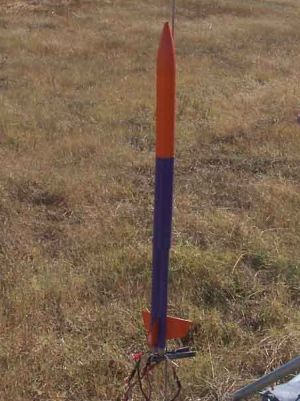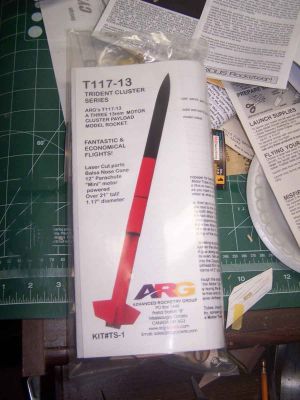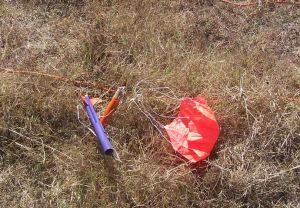Advanced Rocketry Group Ltd. Trident 117-13
Advanced Rocketry Group - Trident 117-13 {Kit} (ARG0213)
Contributed by John Lee
| Construction Rating: | starstarstarstarstar_border |
| Flight Rating: | starstarstarstarstar_border |
| Overall Rating: | starstarstarstarstar_border |
| Diameter: | 1.17 inches |
| Length: | 21.30 inches |
| Manufacturer: | Advanced Rocketry Group |
| Style: | Cluster |

Brief:
Advanced Rocketry Group out of Canada has several interesting models including a series of Black Brandt scales but the ones that captured my attention were the Trident series. They offer what is basically the same rocket in 4 different sizes based upon motor diameter. All are triple clusters and have a payload bay. I got one of each in 13, 18, 24, and 29mm. Because of limited flying opportunities, I decided to go with the 13mm version first.
Construction:
The first step in construction was to lightly sand the 3 BT-5 tubes that will serve as the motor tubes. This was done with #400 sandpaper and the aft end of each tube was chosen and marked.
Each tube needed to have a thrust ring installed 1.5" from the aft end. This was done with yellow glue and using a marked spent casing to shove the ring into place.
Two of the motor tubes were then glued together and efforts were made to ensure that they were straight and even.
The shock cord is a length of Kevlar. The instructions said to knot it at one end and then make another knot 1.5" from the knotted end. I was also to mark the motor tubes 3" back from the forward end. A trough of yellow glue was poured into the "V" between the 2 tubes from the 3" mark to the forward end. The knotted end of the thread was then laid into to the glue and it was allowed to dry.
When the Kevlar was firmly glued into the valley of the 2 motor tubes, the third tube was laid on top and held against the first pair while a pencil was used to mark the lines of contact with the third. Yellow glue was then placed along the lines and the third tube was pressed into place. Care was taken to make sure the ends were aligned and then some cellophane tape was used to hold the assembly together tightly as it dried.
 The cluster bulkhead, the one with three holes in it, was then located and test fit into the airframe. It was a bit tight so the edge was sanded down a bit. When it fit, the Kevlar was threaded through the hole in the middle and the bulkhead was glued to the ends of the motor tubes. Fillets were placed to ensure a good joint.
The cluster bulkhead, the one with three holes in it, was then located and test fit into the airframe. It was a bit tight so the edge was sanded down a bit. When it fit, the Kevlar was threaded through the hole in the middle and the bulkhead was glued to the ends of the motor tubes. Fillets were placed to ensure a good joint.
With the cluster bulkhead secured in place, the motor tubes were marked at a point 2" aft of the forward ends. A ring of glue was smeared along the interior of the airframe body tube and the Kevlar and elastic were allowed to drop through. The motor tubes and bulkhead were then inserted into the airframe tube up to the 2" marks.
The payload bulkhead and the screw eye were located. The screw was twisted into the drilled hole in the center of the bulkhead and the threads on the back side were covered in glue and allowed to dry.
At this point, I found that the tube coupler was missing. I contacted ARG to find out what length they recommended. A while later, I got an email suggesting I look inside the payload tube but telling me that another coupler would be sent. I looked, found it, apologized, and I was impressed with the quick turn around.
The payload bulkhead was seated about 1/8" inside of the tube coupler and glued in place. When dry, both sides were filleted.
As the payload coupler dried, I turned my attention to the fins. While I beveled the leading, trailing, and outer edges of most fins, on this project I also beveled the root edges. This was recommended in the instructions to ensure a better fit between the cluster tubes. As a result, all edges were beveled.
The coupler tube was marked at the 1.25" mark. That's the halfway point. A ring of glue was then smeared into the end of the payload tube and the coupler was inserted.
The motor tubes were marked are quarter inch from their ends and then the process of gluing the fins in place began. The beveling did help.
While the fins were setting up, I gently sanded the nosecone. It was a bit fuzzy. I then applied some Elmer's Wood Filler and put everything away to dry for the night.
On returning to the build, I sanded the NC and then proceeded to begin filleting the fins. I used yellow glue and got it smoothed around the fin/motor tube joint. I also decided to run a fillet in the valley between motor tubes. This was less to strengthen than it was to give a uniform contour for painting.
PROs: Simple build, no tri-fold, instructions are well written.
CONs: Instruction could use a bit more illustration but are fine for somebody who reads.
Finishing:
The nosecone was sealed with Elmer's, but I decided to rely on Kilz to seal the basswood fins. Accordingly, the rocket was set up in the booth and sprayed with Kilz primer. After about an hour, it was given another coat.
The primed rocket was lightly sanded and then I had to decide on the paint job. Orange is probably my least favorite color but I saw a paint job on the 24mm version of this rocket that was very attractive and decided to give it a try. Accordingly, the Trident was put in the booth and given 2 coats of Rustoleum orange.
While the orange paint was drying, I took a closer look at the nice nylon chute provided in the kit. As I did so, the launch lug came bouncing out. I had forgotten to install it. Accordingly, when the paint had dried, I used an X-Acto to scrape away the paint where the lug would be installed. The lug was then glued on. This should not cause any problems since this entire area of the rocket is going to get a differing paint.
I was looking forward to a peaceful evening finishing up some projects. I got to my shop at my nephew's house and started to putter around with various things in the works and then decided I had better get the Trident 13 masked and the next coat of paint on. I looked where I had put it along with several others and they were all on the floor. The others were not damaged but the Trident was. It looked like it had been stepped on.
The payload bay was crushed and the NC has a big smiley dent in it.
I wanted to have this one ready for my meet next Saturday but seemed like a long shot. The tube is not an Estes standard at 1.17 x 5". The closest I found was a series 11 from Semroc. I know their mailing is legendary but...
I used an X-Acto to slice the payload bay the rest of the way open and managed to peel it away from the coupler and bulkhead. I used the razor to trim away some dried glue and test fit it back in the main airframe. It seems to fit if only I can get a tube in time.
Greatly dispirited, I masked off the fins and painted the rest of the intact rocket purple. Even if the coupler arrived Tuesday, there would be no time to give it my original paint job.
Not long after posting the build to this point on TRF, I received confirmation from Semroc. A Series 11 tube is on the way. Apparently, ARG is using Semroc tubing. I thought so because I could not find any other with a 1.17 diameter.
That's beside the point. I owe a big thank you to the fine people at Semroc. This bird might get to fly this weekend after all.
Peeling the masking back from the fins after the purple paint was not a great experience. My Frog tape which had done so well by me in the past let me down and I had hideous purple blobs on the orange. I'd have to clean it up with a brush.
With the purple paint on the Trident fully dry, I decided to try and touch up the purple blobs on the fins. To do this, I took a paper bowl and sprayed in a quantity of the same orange spray paint I had used on the first coat of the rocket. I then used a brush to dab up the paint and paint out the blobs. It took 2 coats and a difference can be seen, but it is much better than before.
The only con I can really think of is that it would be nice to have some sort of distinguishing decal. There are no decals or stickers.
Construction Rating: 4 out of 5
Flight:
The maiden flight of the Trident 13 had its ups and downs. I loaded three 1/2A3-2Ts and hooked up the clip whip. When the button was pushed, it took right off but it did not go very high at all. It ejected and came down very close. On examination, I saw that one of the motors had not ignited. At least I know its stable on just 2.
Video of the maiden flight can be seen here.
The second flight was also problematic. I loaded it with A10-3Ts and hooked up the clip whip. I had continuity tone but nothing happened when the button was pushed. On checking the clip whip, it was secure but I had forgotten to hook the whip to the controller leads. Duh. The tone had come from an expended igniter on a differing circuit that was hanging on to life. When the motors did light, the rocket behaved admirably will all motors ignited.
Video of the second flight can be found here.
PROs: Stable and able to fly safely even when a motor does not ignite, great cluster for small fields, and great cluster for learning.
CONs: None.

Recovery:
As described in the construction section, the shock cord is mounted with a Kevlar thread embedded between the clustered motor tube. This leads to a section of sewing elastic. The kit comes with a high quality nylon chute that is reasonably sized for the rocket.
PROs: First class materials and design.
CONs: Not much room for wadding and stuffing the chute.
Flight Rating: 4 out of 5
Summary:
I think this is a well designed kit put together with quality parts. It is a good introduction to clustering and a good cluster choice for small fields.
Overall Rating: 4 out of 5
 |
 |
Flights
 |
 |
Sponsored Ads
 |
 |












J.A.L. (January 11, 2009)